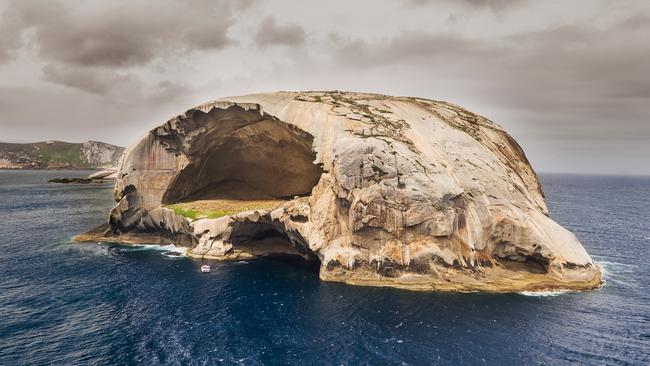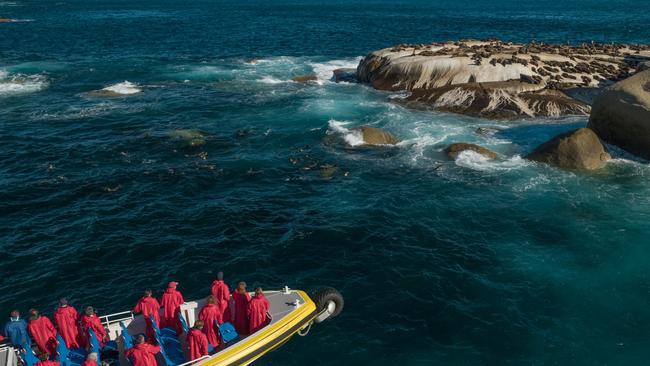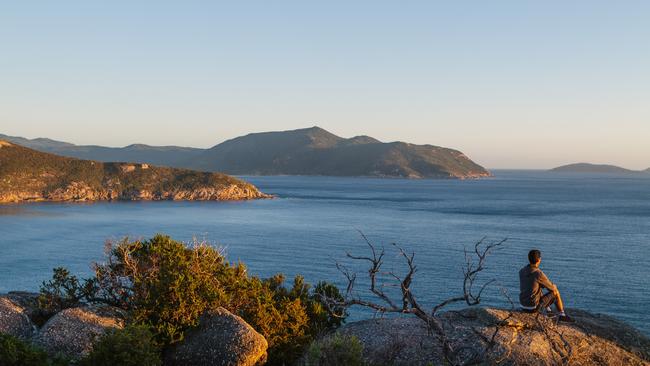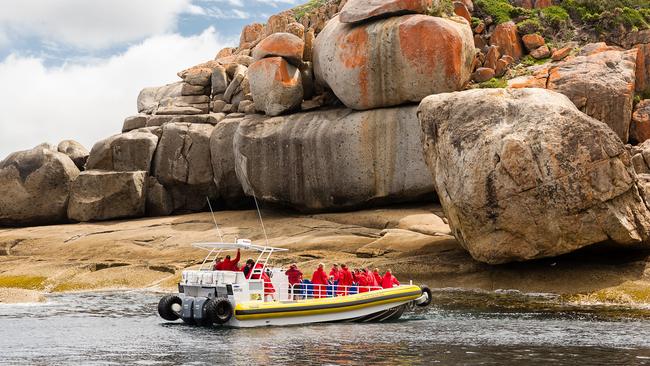Wilsons Promontory cruise explores the mystery of Skull Rock
An astonishing geological feature off Victoria has been explored by fewer people than have walked on the moon.

Where’s James Bond when you need him? I’m being conveyed to a villain’s den, or at least that’s how it feels, strapped into a seat on a big yellow boat with retractable wheels that has rolled across the sand into the surf and is now speeding towards a mysterious uninhabited skull-shaped island off the coast of mainland Australia’s southernmost tip.
Rising from the sea in the shape of a gigantic bird’s skull, Cleft Island — otherwise known as Skull Rock — is the perfect bad guy’s lair. As we cruise past the pointed “beak’’, craning our necks to look up at the monstrous hollowed eye sockets looming above us, the island slowly reveals the distinguishing feature that would make any evil mastermind in search of a secret hideout go weak at the knees. The eerily shaped granite monolith is actually hollow, a massive chamber 60m above the roiling sea. Carpeted with grass, it’s large enough to hide the sails of the Sydney Opera House inside.
With no safe place to anchor and no safe way of scaling the sheer cliffs, Skull Rock has, according to eco-tour operator Rob Pennicott, been explored by fewer people (nine) than have walked on the moon (12). Located about 5km off the coast of Wilsons Promontory, it’s the star attraction of Pennicott’s new Wilsons Promontory Cruise, a 2½ hour wildlife and sightseeing cruise that launched in late September.

Pennicott has been operating award-winning wilderness cruises in Tasmania — around Bruny Island, Hobart and the Tasman Peninsula — for 21 years, but this is his first on mainland Australia. It’s also the first, and only, cruise to be operating from Wilsons Promontory National Park in Victoria.
“Every time I have taken boats across Bass Strait I always spend a couple of hours around the islands of Wilsons Promontory,” Pennicott says. “I feel a spiritual connection to the area and I believe its flora, fauna and geology are out of this world.”
One of the oldest national parks in Victoria, the Prom, as it’s known to locals, hangs off the southern edge of the mainland like a fishhook-shaped pendant. With extensive beachside camping grounds it’s always been a popular place to go wild; almost every Melburnian has at least one “night at the Prom’’ story from their childhood or teenage years. But until now the only way to explore the park has been on foot on the network of walking trails (many involving camping overnight along the way) that lead to deserted beaches and lookouts. Pennicott’s cruise now means you can see some of the park’s most far-flung reaches without lacing up hiking boots or lugging a heavy pack full of freeze-dried food.
The tours depart from Norman Beach, near the Tidal River Visitor Centre. Leaving next to no environmental footprint, the custom-made amphibious boats can drive straight into the sea, and are boarded by a portable staircase so there’s no need to worry about getting wet feet.

Whether the rest of you gets wet though is entirely at the whim of the weather, although full-length hooded rain jackets are provided.
We’ve hardly left the beach when we’re distracted by the spectacle of a group of gannets swooping and diving headfirst into the water with a splash. “It’s a feeding frenzy,” explains our skipper. “There’s a bait ball below the surface.” Somewhere, from the vault of useless information I keep in the back of my brain, I recall that the collective noun for gannets is a “plunging”. Now I know why.
The Prom’s coastline is outrageously scenic; a string of dazzling white sand beaches flanked by a jumbled mess of lichen-streaked boulders that look as if they are set to tumble into the sea the moment a breeze blows in. It’s part of the same granite range that forms the mountainous spine along the east coast of Tasmania, including the famous rock peaks of the Freycinet Peninsula. Scanning the horizon, which is cloaked in a gauzy veil of sea mist, the sea is littered with rocky islets, each wearing its own cap of clouds. One of the largest, Rodondo, is the northernmost of Tasmania’s Bass Strait islands.

As we skirt the very southern tip of the mainland, we find ourselves surrounded by half a dozen humpback whales, energetically slapping their fins and breaching, sometimes less than 30m from our boat. They are soon joined by a pod of dolphins and some seals. No one knows quite where to look, there’s so much wildlife on show in every direction.
At Kanowna Island, named for a steamer that served as a hospital ship in World War I and sank after striking neighbouring Skull Rock in 1929, we are greeted by a large herd of seals and year-old pups frolicking in the water, while countless more snooze in the sun on the rocky slopes. One of the country’s largest fur seal breeding colonies, Kanowna is home to roughly 9000 of them, and we sniff them out long before we see them. They sound like sheep, and smell like an overflowing rubbish bin on a hot day. Where there are seals there are usually sharks, explains our skipper, who says there’s a white pointer nursery on the other side of the island and sightings of 5m sharks are not uncommon. It might be the natural way of things, but I keep my fingers crossed we don’t see any seals slaughtered while bobbing about in the sea today.
Until now, few people have ever had the chance to get this close to Skull Rock. The only recorded visits were a small group of intrepid rock climbers in 1972 who abseiled into the void of the massive cave 130m wide and 60m deep. Once inside, the climbers reportedly found the remains of rusted cannon balls; when and by whom they were fired remains a mystery. The next visitors — TV presenter Neil Oliver (Coast) and his film crew in 2017 — were also helicoptered on to the island and abseiled in.
Our big yellow boat with wheels is a much easier option, and as we head back towards Norman Beach, cruising alongside the edge of the Glennie Islands, wild grass-covered rocky outposts inhabited only by seals, Cape Barren Geese, eagles, cormorants and other birds, it strikes me that this landscape, too, would be the ideal location for a Bond film. There’s even a sheltered cove, where Daniel Craig — or whoever is the next reincarnation of the famous spy — could emerge from the teal green sea in tight blue swimming trunks. If 007 ever visits the Prom, I know just where he (or she) should go.
Lee Atkinson was a guest of Visit Victoria and Pennicott Wilderness Journeys.
-
MORE TO THE STORY
A percentage of the proceeds from each Wilsons Promontory Cruise goes to philanthropy projects. “Through our business and the Pennicott Foundation we gave over $640,000 to support 460 community, charity and environmental projects in the last 12 months,” says Rob Pennicott, who is keen to help restore these uninhabited islands back to the way they were pre-human contact. “This year we have pledged $50,000 to a conservation project in the region. A likely project is weed eradication on islands in the Wilsons Promontory Marine National Park.”
-
IN THE KNOW
Wilsons Promontory National Park is 220km south-east of Melbourne, via the South Gippsland Highway. Wilsons Promontory Cruises depart daily from Tidal River in Wilsons Promontory National Park, more frequently in summer and school holidays; $135 an adult, $85 a child.
